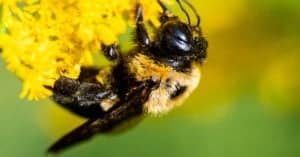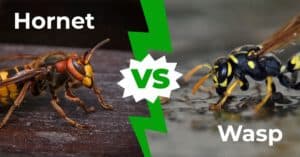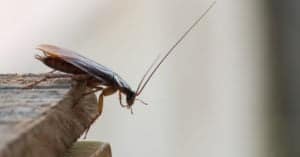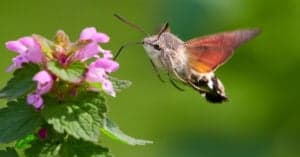Mud Dauber vs Termite: Key Differences Explained
@media (min-width: 481px) {
.mobile-top-content {
display: none;
}
}
#mobileTopContentCTACarouselControls { overflow: hidden; text-overflow: ellipsis; white-space: nowrap; }
.mobile-top-content .more { color: #fff; }
.mobile-top-content a { color: #fff; text-decoration: underline; }
.mobile-top-content a:hover { color: #fff; text-decoration: underline; }
@media (max-width: 480px) {
.mobile-top-content {
background-color: #06a10b;
color: #fff;
text-align: center;
/*height: 60px;
padding-top:5px;*/
font-size:80%;
/* display: block; */
margin: 0px -30px;
}
}
Many insects construct elaborate nests from materials that humans often use to build their own homes! Of the many insects that make their homes with unique materials, the mud dauber and the termite are among the most famous. Although these two insects are quite different, they do have some similarities that cause people to confuse the two of them. Today, we are going to explore the difference between the two. Let’s discover: Mud Dauber vs Termite; what makes them different?
Comparing a Mud dauber and a Termite
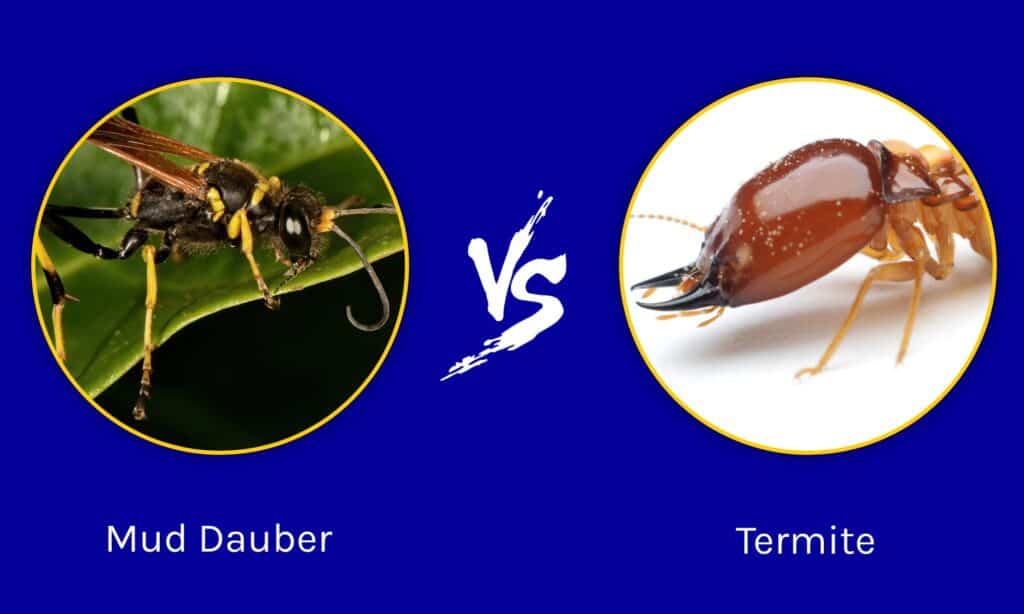
A-Z-Animals.com
| Mud Dauber | Termite | |
|---|---|---|
| Size | Long, slender wasps. Usually 1 inch long. | Small, ant-sized insects. Usually 4-15 millimeters in length. |
| Nests | Long and tubelike. Built from a mixture of mud and saliva. | Expansive and complex. Built from wood, saliva, and mud. |
| Diet | Spiders and other insects. | Wood. |
| Social structure | Solitary hunting wasps. | Complex caste system. |
The 5 key differences between a mud dauber and a termite
The primary differences between a mud dauber and a termite are their size, social structure, and nest construction. Mud daubers are common wasps across much of the United States, often placing nests around homes, patios, and park shelters. Termites are small insects known for their large colonies and destructive habit of eating wood (especially human structures).
Between the two, there are more differences than there are similarities. Still, they are often confused as mud daubers construct nests with mud tubes, a practice that termites occasionally use when building their nests.
Let’s explore what makes them different in some detail!
Mud Dauber vs Termite: Taxonomy
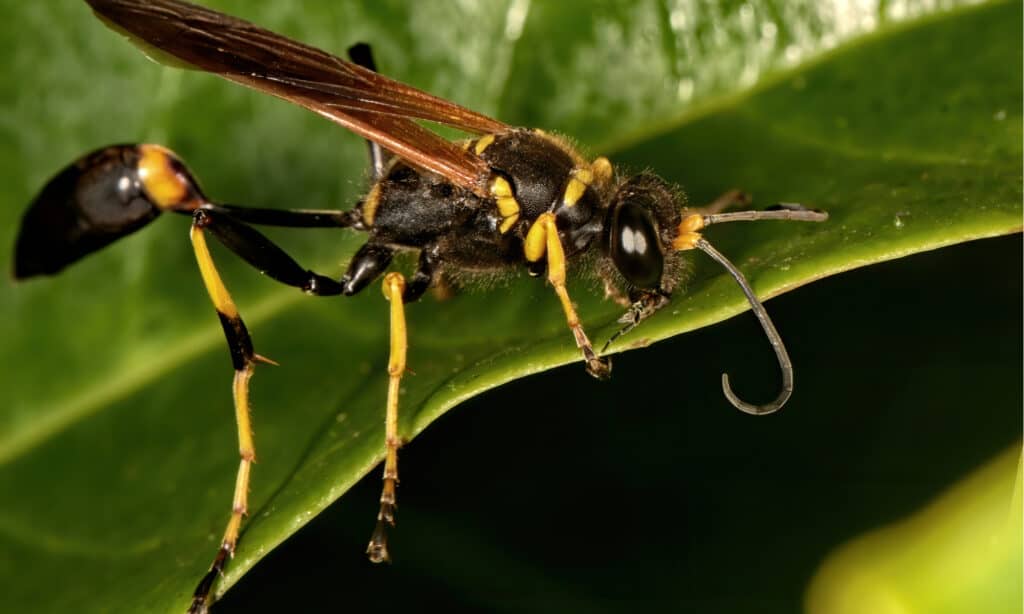
Russell Marshall/Shutterstock.com
Dirt daubers and mud wasps are commonly used to refer to mud daubers. Regardless, they refer to a group of wasps that build their nests from mud. They can belong to one of two families: Sphecidae or Crabronidae. In the United States, mud dauber nests can be found almost anywhere there are outdoor structures with dirt available nearby.
Termites are also a common insect in the United States known for eating wood, often resulting in structural damage to homes and businesses where they go undetected. They belong to the Blattodea order, alongside their “sister insects,” cockroaches. In fact, termites likely evolved from wood-eating cockroaches a few million years ago during the Jurassic period. Although they look like ants and are often referred to as “white ants,” termites aren’t related closely related to them at all.
Mud Dauber vs Termite: Size
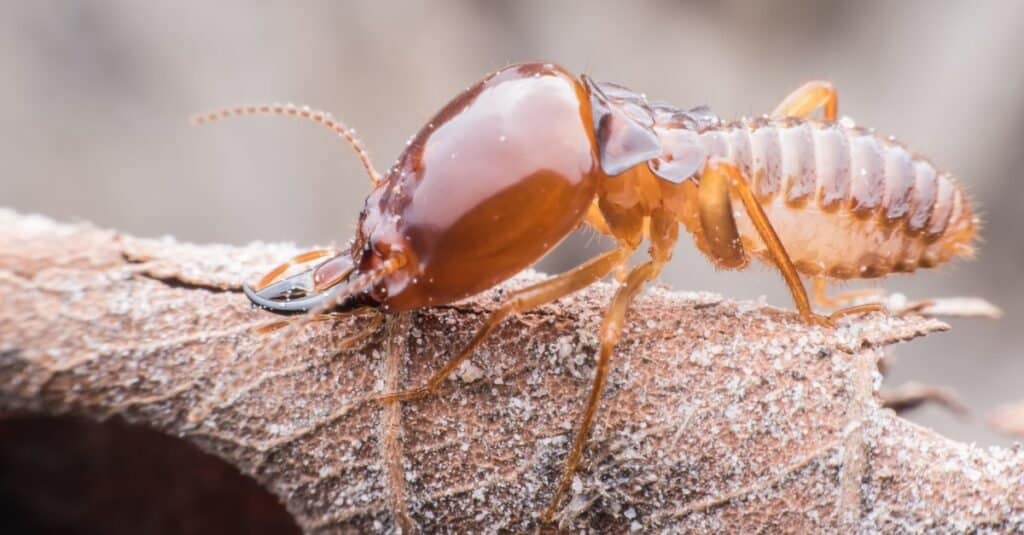
PK289/Shutterstock.com
When it comes to size, mud daubers are significantly larger than termites. Daubers are wasps and look just like other wasps would. They generally have a very thin “waist” that connects their abdomen and thorax, as this is characteristic of many solitary wasps (of which the mud dauber is a member). Most mud daubers are about an inch long, have six legs, and three body parts split into a head, thorax, and abdomen. Additionally, all adults have wings.
Termites are much smaller than mud daubers. Most termites are comparable to a smaller species of ant and can range from 4-15mm in length. The queen is the largest termite in the nest, with the workers being significantly smaller. Although they have a head, thorax, and abdomen, the thorax and abdomen aren’t clearly discernable like they are on a wasp or ant.
Mud Dauber vs Termite: Nests
The nest-building process for mud daubers is a big differentiator between these two insects. Mud daubers build their nests from mud (as their name suggests) that normally take the shape of long cylinders. Each tube has cells inside that house an egg that will later grow into a full-grown wasp. Over time mud daubers will stack these cylinders, creating small structures. Still, even after a few years, these structures are significantly smaller than termite nests.
Termite nests are expansive and intricate. In some sub-terranean nests across the world, their nests have been spread over a 100-meter radius. The exact type of nest depends on the species of termite that made it (there are thousands), but the ones that most people in the United States would see in their homes aren’t visible without investigation. Drywood and dampwood termites (the two types that would be in your home) both build their nests in the wood they eat, making it tough to see. They generally build tunnels and tubes through the wood with cavities designed for larva and egg-laying. Common signs of dry wood and dampwood termites are small sawdust piles, small pinholes in wood, and fecal matter.
Mud Dauber vs Termite: Diet

Maciej Olszewski/Shutterstock.com
As a member of the wasp family, mud daubers are predatory. Additionally, they are solitary wasps that go by the secondary name of “hunting wasps.” Mud daubers are known for their pest control, specifically in relation to spiders. They will paralyze spiders and lay their eggs in their bodies for later food. Mud daubers greatly reduce spider populations to help keep them in check. Aside from spiders, mud daubers will eat other small insects and pollen.
Termites are less general in their diets. As most people know, termites eat wood, although that isn’t the primary thing they are looking for. More specifically, termites like to eat cellulose, which wood is made of. In a home environment, termites are known to eat plants, carpets, insulation, fabric, and more. A large colony can go through an entire 2×4 in only a few months, showing an example of their destructive capabilities.
Mud Dauber vs Termite: Social structure
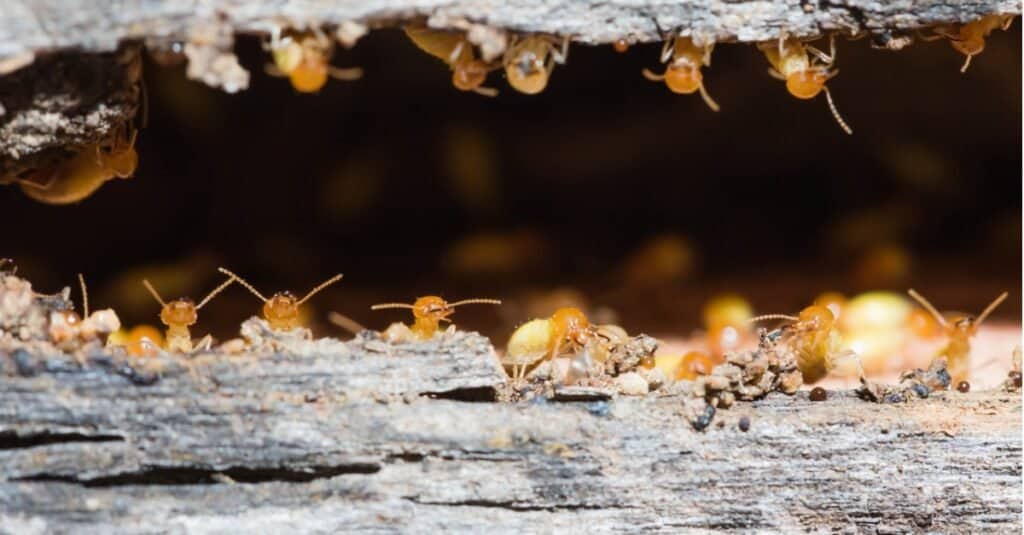
iStock.com/chyball
The social structure between these two insects is almost totally opposite. Mud daubers are solitary wasps, meaning they don’t live in large nests or colonies like others species of wasps would. Instead, they live and hunt by themselves, rarely interacting with other species members.
On the other hand, termites have some of the most complex social structures of any animal on the planet. They have a caste system with each member having a specific role. Here is the caste system for a typical termite nest:
A – King
B – Queen
C – Secondary queen
D – Tertiary queen
E – Soldiers
F – Worker
Within this caste are even small segments. For example, there are different types of soldiers with different jobs.
More from A-Z Animals
.more-snake-card-image { max-height:140px !important; }
@media (min-width: 481px) {
.mobile-top-content {
display: none;
}
}
#mobileTopContentCTACarouselControls { overflow: hidden; text-overflow: ellipsis; white-space: nowrap; }
.mobile-top-content .more { color: #fff; }
.mobile-top-content a { color: #fff; text-decoration: underline; }
.mobile-top-content a:hover { color: #fff; text-decoration: underline; }
@media (max-width: 480px) {
.mobile-top-content {
background-color: #06a10b;
color: #fff;
text-align: center;
/*height: 60px;
padding-top:5px;*/
font-size:80%;
/* display: block; */
margin: 0px -30px;
}
}
Many insects construct elaborate nests from materials that humans often use to build their own homes! Of the many insects that make their homes with unique materials, the mud dauber and the termite are among the most famous. Although these two insects are quite different, they do have some similarities that cause people to confuse the two of them. Today, we are going to explore the difference between the two. Let’s discover: Mud Dauber vs Termite; what makes them different?
Comparing a Mud dauber and a Termite

A-Z-Animals.com
| Mud Dauber | Termite | |
|---|---|---|
| Size | Long, slender wasps. Usually 1 inch long. | Small, ant-sized insects. Usually 4-15 millimeters in length. |
| Nests | Long and tubelike. Built from a mixture of mud and saliva. | Expansive and complex. Built from wood, saliva, and mud. |
| Diet | Spiders and other insects. | Wood. |
| Social structure | Solitary hunting wasps. | Complex caste system. |
The 5 key differences between a mud dauber and a termite
The primary differences between a mud dauber and a termite are their size, social structure, and nest construction. Mud daubers are common wasps across much of the United States, often placing nests around homes, patios, and park shelters. Termites are small insects known for their large colonies and destructive habit of eating wood (especially human structures).
Between the two, there are more differences than there are similarities. Still, they are often confused as mud daubers construct nests with mud tubes, a practice that termites occasionally use when building their nests.
Let’s explore what makes them different in some detail!
Mud Dauber vs Termite: Taxonomy

Russell Marshall/Shutterstock.com
Dirt daubers and mud wasps are commonly used to refer to mud daubers. Regardless, they refer to a group of wasps that build their nests from mud. They can belong to one of two families: Sphecidae or Crabronidae. In the United States, mud dauber nests can be found almost anywhere there are outdoor structures with dirt available nearby.
Termites are also a common insect in the United States known for eating wood, often resulting in structural damage to homes and businesses where they go undetected. They belong to the Blattodea order, alongside their “sister insects,” cockroaches. In fact, termites likely evolved from wood-eating cockroaches a few million years ago during the Jurassic period. Although they look like ants and are often referred to as “white ants,” termites aren’t related closely related to them at all.
Mud Dauber vs Termite: Size

PK289/Shutterstock.com
When it comes to size, mud daubers are significantly larger than termites. Daubers are wasps and look just like other wasps would. They generally have a very thin “waist” that connects their abdomen and thorax, as this is characteristic of many solitary wasps (of which the mud dauber is a member). Most mud daubers are about an inch long, have six legs, and three body parts split into a head, thorax, and abdomen. Additionally, all adults have wings.
Termites are much smaller than mud daubers. Most termites are comparable to a smaller species of ant and can range from 4-15mm in length. The queen is the largest termite in the nest, with the workers being significantly smaller. Although they have a head, thorax, and abdomen, the thorax and abdomen aren’t clearly discernable like they are on a wasp or ant.
Mud Dauber vs Termite: Nests
The nest-building process for mud daubers is a big differentiator between these two insects. Mud daubers build their nests from mud (as their name suggests) that normally take the shape of long cylinders. Each tube has cells inside that house an egg that will later grow into a full-grown wasp. Over time mud daubers will stack these cylinders, creating small structures. Still, even after a few years, these structures are significantly smaller than termite nests.
Termite nests are expansive and intricate. In some sub-terranean nests across the world, their nests have been spread over a 100-meter radius. The exact type of nest depends on the species of termite that made it (there are thousands), but the ones that most people in the United States would see in their homes aren’t visible without investigation. Drywood and dampwood termites (the two types that would be in your home) both build their nests in the wood they eat, making it tough to see. They generally build tunnels and tubes through the wood with cavities designed for larva and egg-laying. Common signs of dry wood and dampwood termites are small sawdust piles, small pinholes in wood, and fecal matter.
Mud Dauber vs Termite: Diet

Maciej Olszewski/Shutterstock.com
As a member of the wasp family, mud daubers are predatory. Additionally, they are solitary wasps that go by the secondary name of “hunting wasps.” Mud daubers are known for their pest control, specifically in relation to spiders. They will paralyze spiders and lay their eggs in their bodies for later food. Mud daubers greatly reduce spider populations to help keep them in check. Aside from spiders, mud daubers will eat other small insects and pollen.
Termites are less general in their diets. As most people know, termites eat wood, although that isn’t the primary thing they are looking for. More specifically, termites like to eat cellulose, which wood is made of. In a home environment, termites are known to eat plants, carpets, insulation, fabric, and more. A large colony can go through an entire 2×4 in only a few months, showing an example of their destructive capabilities.
Mud Dauber vs Termite: Social structure

iStock.com/chyball
The social structure between these two insects is almost totally opposite. Mud daubers are solitary wasps, meaning they don’t live in large nests or colonies like others species of wasps would. Instead, they live and hunt by themselves, rarely interacting with other species members.
On the other hand, termites have some of the most complex social structures of any animal on the planet. They have a caste system with each member having a specific role. Here is the caste system for a typical termite nest:
A – King
B – Queen
C – Secondary queen
D – Tertiary queen
E – Soldiers
F – Worker
Within this caste are even small segments. For example, there are different types of soldiers with different jobs.

